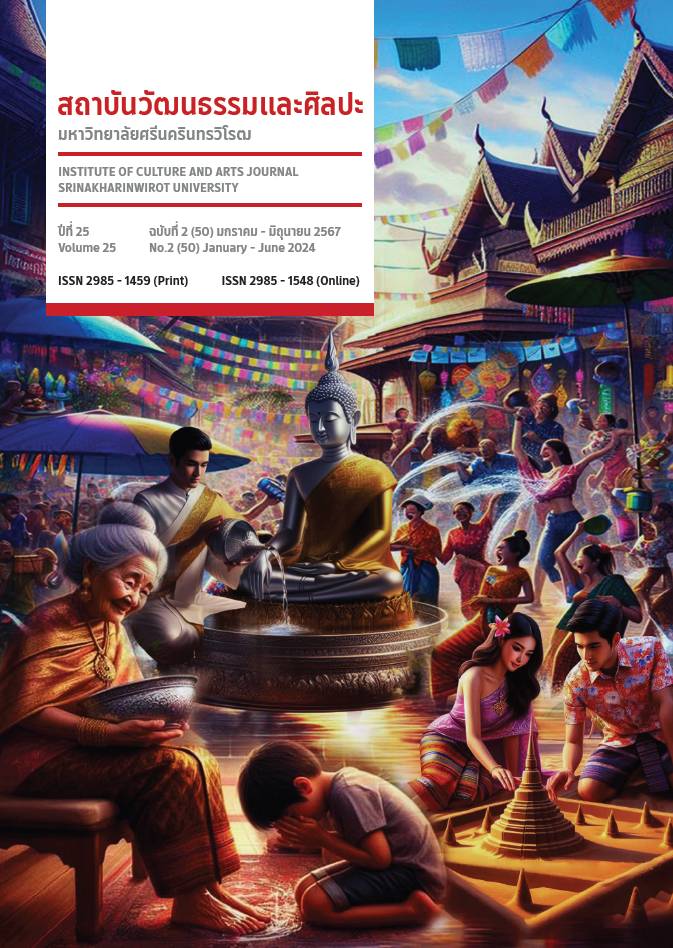เงื่อนไขการสร้างสรรค์สื่อนิทานประกอบภาพเพื่อการเรียนรู้โรคระบาดโควิด 19 สำหรับเด็กมุสลิมในพื้นที่สามจังหวัดชายแดนภาคใต้
บทคัดย่อ
บทความวิจัยเชิงคุณภาพนี้ มีวัตถุประสงค์เพื่อศึกษาเงื่อนไขการสร้างสรรค์สื่อนิทานประกอบภาพเพื่อการเรียนรู้โรคระบาดโควิด 19 สำหรับเด็กมุสลิมในพื้นที่สามจังหวัดชายแดนภาคใต้ รวบรวมข้อมูลโดยการสนทนากลุ่ม และการสัมภาษณ์เชิงลึก กำหนดกลุ่มผู้ให้ข้อหลัก 6 กลุ่มโดยการเลือกแบบเจาะจง ได้แก่ 1) แกนนำชุมชนมุสลิม 2) ผู้นำศาสนาอิสลาม 3) นักวิชาการมุสลิม 4) นักสาธารณสุขมุสลิม 5) ประชาชนมุสลิม และ 6) เยาวชนมุสลิม รวมทั้งสิ้น 18 คน ตรวจสอบข้อมูลแบบสามเส้าด้านข้อมูล (Data triangulation) วิเคราะห์ข้อมูลแบบสร้างบทสรุป นําเสนอผลการวิเคราะห์ในรูปแบบรายงานเชิงพรรณนาวิเคราะห์
ผลการวิจัยพบว่า เงื่อนไขการสร้างสรรค์สื่อนิทานประกอบภาพเพื่อการเรียนรู้โรคระบาดโควิด 19 สำหรับเด็กมุสลิมในพื้นที่สามจังหวัดชายแดนภาคใต้ มีเงื่อนไขสำคัญ 5 ประการ 1) เงื่อนไขด้านศาสนาและบริบทวัฒนธรรมมลายูมุสลิม การสร้างนิทานควรใช้อักษรยาวี ชื่อและตัวละครควรแสดงอัตลักษณ์วัฒนธรรมท้องถิ่น ตัวละครสามารถแสดงให้เห็นถึงขนบธรรมเนียมประเพณีของชาวมุสลิมที่เชื่อมโยงกับหลักศาสนาอิสลาม 2) เงื่อนไขด้านเนื้อหา ควรนำเสนอทั้งด้านบวกและด้านลบ เนื้อหามีความพอดี ระมัดระวังการนำเสนอประเด็นความเชื่อ ควรสะท้อนความเชื่อในศาสนา วิถีวัฒนธรรมมลายู และเนื้อหาควรถูกกำหนดโดยชุมชน 3) เงื่อนไขด้านภาษา ควรเลือกใช้ภาษาที่สอดคล้องกับท้องถิ่น โดยเฉพาะภาษามลายูท้องถิ่น มลายูกลาง รวมถึงควรใช้ภาษาไทยร่วมด้วย 4) เงื่อนไขด้านภาพประกอบ ควรแสดงถึงสภาพภูมิศาสตร์ สิ่งแวดล้อม ทรัพยากรในชุมชน วัฒนธรรม ความรู้ และความเชื่อที่เกี่ยวเนื่องกับอัตลักษณ์ชาวมลายูมุสลิม 5) เงื่อนไขด้านการเผยแพร่ ต้องคำนึงถึงกระบวนการสื่อสารแบบมีส่วนร่วมโดยชุมชนเข้ามามีบทบาทสำคัญ ทั้งนี้ช่องทางการสื่อสาร ผู้รับสาร ผลของการสื่อสารเป็นสิ่งที่ต้องตระหนักและให้ความสำคัญ
Downloads
เอกสารอ้างอิง
กษริน วงศ์กิตติชวลิต ปิยณัฐ สุนทรประเสริฐ และ วรรณนิสา ปานพรม. (2565). คุณค่าที่ปรากฏในวรรณกรรมสำหรับเด็กที่ได้รับรางวัลหนังสือดีเด่น จากคณะกรรมการการศึกษาขั้นพื้นฐานปี พ.ศ. 2560-2565. วารสารสังคมศาสตร์, 11(2),12-27.
เกศราพร ทองพุ่มพฤกษา. (2566). หนังสือนิทานภาพสำหรับเด็กกับการเล่าเรื่องคุกคามทางเพศ. วารสารศาสตร์. ปีที่ 16 ฉบับที่1 (มกราคม-เมษายน 2566)
เกษตรชัย และหีม. (2560). เยาวชนมุสลิมกับพฤติกรรมตามวิถีอิสลาม. กรุงเทพฯ : โอ.เอส.พริ้นติ้งเฮาส์.
ชรินทร์ มั่งคั่ง. (2560). อุดมคติวิทยาหลักสูตรสังคมศึกษาเพื่อปวงชน. พิมพ์ครั้งที่ 3. กรุงเทพฯ : จุฬาลงกรณ์มหาวิทยาลัย.
นิคม สุวพงษ์. (2565). การถอดบทเรียน : เพื่อเสริมสร้างกระบวนการเรียนรู้. วารสารบัณฑิตสาเกตปริทรรศน์. ปีที่ 7 ฉบับที่ 1 มกราคม - มิถุนายน 2565
นีนนิมมาน ยอดเมือง. (2566). บารมีดีที่ตน: แนวคิดทศบารมีและกลวิธีการเล่านิทานชาดกสำหรับเด็กในสื่อใหม่. วารสารภาษาและวรรณคดีไทย. ปีที่ 40 ฉบับที่ 1 (มกราคม - มิถุนายน 2566).
ปัญญา เทพสิงห์, เกษตรชัย และหีม, เก็ตถวา บุญปราการ, และเจตสฤทธิ์ สังขพันธ์. (2561). ลักษณะบ้านใน วัฒนธรรมมลายู: ศึกษากรณีกัมปงไอเยอร์ ประเทศบรูไนดารุสซาลาม. วารสารวิทยบริการ มหาวิทยาลัยสงขลานครินทร์, 29(3), 190-201.
ผาสุก แก้วเจริญตา, มาลินี ยามา, ชัยรัตน์ ลำโป, และสุเทพ เพชรมาก. (2566). พลังเอื้ออารี พาคนปัตตานีฝ่าวิกฤติโควิด 19. ปัตตานี : สำนักงานสาธารสุขจังหวัดปัตตานี.
ไพบูลย์วรรณ จิตพัฒนกุล และศิริพร งามขจิต. (2566). การศึกษาลักษณะของตัวละคร ฉาก และองค์ประกอบการเล่า เรื่องจากภาพผ่านวรรณกรรมสำหรับเด็กประเภทบันเทิงคดีที่ได้รับรางวัลหนังสือดีเด่นจากคณะกรรมการการศึกษาขั้น พื้นฐานระหว่างปีพุทธศักราช 2560 – 2565. วารสารการบริหารการปกครองและนวัตกรรมท้องถิ่น, 7(2), 205- 224.
ยุทธนา เกื้อกูล. (2566). การจัดการศึกษาในอิสลาม. ปัตตานี : มหาวิทยาลัยสงขลานครินทร์.
วินัย ครุวรรณพัฒน. (2523). ทัศนะของคนไทยใน 4 จังหวัดภาคใต้. (รายงานการวิจัย) ม.ป.ท.
อดัม คูชาร์สกี้. (2563). ระเบียบแห่งการระบาด. กรุงเทพฯ : บิบลิโอ.
อภิรัจ พุสวัสดิ์. (2564). นวัตกรรมการสื่อสารแบบมีส่วนร่วม. กรุงเทพฯ : สำนักพิมพ์จุฬาลงกรณ์มหาวิทยาลัย.
อภิวัฒน์ รัตนวราหะ. (2563). อนาคตศึกษา. พิมพครั้งที่ 2. เชียงใหม่.
อรศรี งามวิทยาพงศ์. (2549). กระบวนการเรียนรู้ในสังคมไทยและการเปลี่ยนแปลง. กรุงเทพฯ : จุฬาลงกรณ์มหาวิทยาลัย.
อ้อมใจ วงษ์มณฑา. (2559). ตัวตนคนมลายูมุสลิมในจังหวัดยะลา. วารสารกึ่งวิชาการรูสะมิแล. ปีที่ 37 ฉบับที่ 2 พฤษภาคม-สิงหาคม 2559.
อับดุลเลาะ เจ๊ะหลง และจิรัชยา เจียวก๊ก. (2563). การถอดบทเรียนเพื่อการเรียนรู้ตลอดชีวิตในมนุษย์. วารสารบัณฑิตศึกษามหาวิทยาลัยราชภัฏวไลยอลงกรณ์ ในพระบรมราชูปถัมภ์. ปีที่ 14 ฉบับที่ 2 พฤษภาคม – สิงหาคม 2563.
Aisyashafie. (2011). Definition of the Malay culture. Retrieved from http://www.studymode.com/essays/ Definition-Of-a-Malay-Culture-870351.html.
Helen Bee. (1975). Moral Development. The Developing Child London. United States of America.
ดาวน์โหลด
เผยแพร่แล้ว
รูปแบบการอ้างอิง
ฉบับ
ประเภทบทความ
สัญญาอนุญาต
ลิขสิทธิ์ (c) 2024 วารสารสถาบันวัฒนธรรมและศิลปะ

อนุญาตภายใต้เงื่อนไข Creative Commons Attribution-NonCommercial-NoDerivatives 4.0 International License.
บทความทุกบทความที่ได้รับการตีพิมพ์ถือเป็นลิขสิทธิ์ของวารสารสถาบันวัฒนธรรมและศิลปะ มหาวิทยาลัยศรีนครินทรวิโรฒ



